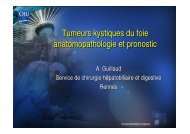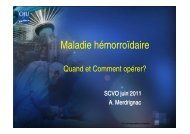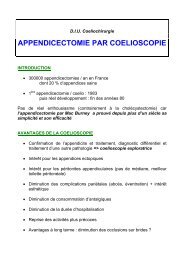Comment s'infecte une prothèse pariétale ? - chirurgie viscérale de l ...
Comment s'infecte une prothèse pariétale ? - chirurgie viscérale de l ...
Comment s'infecte une prothèse pariétale ? - chirurgie viscérale de l ...
Create successful ePaper yourself
Turn your PDF publications into a flip-book with our unique Google optimized e-Paper software.
<strong>Comment</strong> s’infecte <strong>une</strong> <strong>prothèse</strong> <strong>pariétale</strong> ?<br />
Pierre-Yves Lefant<br />
Service <strong>de</strong> Chirurgie Viscérale et Endocrinienne<br />
CHU <strong>de</strong> Poitiers
Introduction<br />
Pathologie <strong>pariétale</strong> , fréquente.<br />
prévalence > 5%<br />
27 % <strong>de</strong>s hommes bénéficieront d’<strong>une</strong> <strong>chirurgie</strong> <strong>pariétale</strong><br />
3 % <strong>de</strong>s femmes (Luciano Zogbi (2011). The Use of Biomaterials to Treat Abdominal Hernias, Biomaterials Applications<br />
for Nanomedicine, Prof. Rosario Pignatello (Ed.)<br />
Réparation <strong>pariétale</strong>, quotidien du <strong>chirurgie</strong>n général et digestif<br />
Prothèses <strong>pariétale</strong>s <strong>de</strong> renfort utilisées <strong>de</strong>puis longtemps<br />
- en argent ( Witzel , 1889 )<br />
- aluminium, cuivre, acier inoxydable (Toilinox ® ) en 1940<br />
Premières <strong>prothèse</strong>s synthétiques dans les années 50<br />
- polypropylene aux Etats-Unis (Usher FC, Ochsner J, Tuttle Jr LL. Use of marlex mesh<br />
in the repair of incisional hernias. Am Surg 1958;24(12):969—74.<br />
- polyester en Europe (Rives J, Stoppa R, Fortesa L, et al. Dacron patches andtheir place in surgery of groin<br />
hernia. 65 cases collectedfrom a complete series of 274 hernia operations. Ann Chir1968;22(3):159—71.)
Introduction<br />
Hernie <strong>de</strong> l’aine : LICHTENSTEIN = gold standard<br />
Permettent <strong>une</strong> franche diminution <strong>de</strong>s récidives<br />
- traitement <strong>de</strong>s hernies <strong>de</strong> l’aine : diminution du risque <strong>de</strong> 50 à 75 %<br />
Scott NW, McCormack K, Graham P, et al. Open mesh versus non-mesh for repair of femoral and inguinal hernia. Cochrane Database Syst Rev 2002;4:CD002197.<br />
- traitement <strong>de</strong>s éventrations : diminution du risque <strong>de</strong> 50 %<br />
Luijendijk RW, Hop WC, van <strong>de</strong>n Tol MP, et al. A comparison of suture repair with mesh repair for incisional hernia. N Engl J<br />
Med 2000;343(6):392—8<br />
Dogme chirurgical : risque infectieux majoré avec matériel étranger.<br />
<strong>Comment</strong> le réduire ?<br />
En connaissant les mécanismes <strong>de</strong> contamination et en<br />
i<strong>de</strong>ntifiant les facteurs <strong>de</strong> risque.
Epidémiologie<br />
Inci<strong>de</strong>nce <strong>de</strong>s infections <strong>de</strong> matériel prothétique : littérature discordante …<br />
◦ Cure <strong>de</strong>s hernies <strong>de</strong> l’aine :<br />
2,6 % (Reduction of the complication rate in Liechtenstein hernia repair E. Just*, X. Botet, S. Martínez, D. Escolà, I. Moreno, E. Duque)<br />
1.4 à 2.9 % (Cochrane Database Syst Rev 2009) antibioprophylaxie (Sanchez-Manuel FJ, Seco-Gil JL. Antibiotic prophylaxis for<br />
hernia repair.)<br />
9 à 18 % (Novel in Vitro Mo<strong>de</strong>l for Assessing Susceptibility of Synthetic Hernia Repair Meshes to Staphylococcus aureus Infection Using<br />
Green Fluorescent Protein-Labeled Bacteria and Mo<strong>de</strong>rn Imaging Techniques)<br />
◦ Traitement <strong>de</strong>s éventrations<br />
6 à 10% voie ouverte<br />
0 à 3.6% par cœlioscopie<br />
0.7 % à 2 % ( coelioscopie ) Novel in Vitro Mo<strong>de</strong>l for Assessing Susceptibility of Synthetic Hernia Repair<br />
Meshes to Staphylococcus aureus Infection Using Green Fluorescent Protein-Labeled Bacteria and Mo<strong>de</strong>rn Imaging Techniques Ihab<br />
Halaweish, 1 Karem Harth,2 Ann-Marie Broome,3 Gabriela Voskerician,4,6 Michael R. Jacobs,1,5 and Michael J. Rosen2
Epidémiologie<br />
65 % <strong>de</strong>s <strong>prothèse</strong>s explantées le sont pour sepsis (Abdominal wall incisional hernias. Infected<br />
prosthesis : Treatment and preventionJ.-F. Gillion a, J.-P. Palot)<br />
Conséquences :<br />
- Échec du traitement initial<br />
- Chirurgies itératives : <strong>de</strong> 1 à 5 interventions supplémentaires (Cobb WS, Carbonell AM, Kalbaugh CL, et al.<br />
Infection risk of open placement of intraperitoneal composite mesh. Am Surg 2009; 75: 762–768)<br />
- Impact socio-économique non négligeable<br />
Potentiellement dramatique …
Diagnostic<br />
Présentation clinique variable<br />
Délai d’apparition <strong>de</strong>s signes : 2 semaines à 39 mois (Mesh-related infections after hernia repair<br />
surgeryM. E. Falagas1,2 and S. K. Kasiakou11Alfa HealthCare, Athens, Greece and 2Tufts University School of Medicine, Boston, MA, USAClin Microbiol<br />
Infect 2005; 11: 3–8)<br />
Érythème, abcès sous cutané, sinus chronique, fistule entéro-cutanée, fièvre<br />
au long cours …
Diagnostic<br />
Certitu<strong>de</strong> : bactériologie sur <strong>prothèse</strong> ou liqui<strong>de</strong> péri-prothétique<br />
Signes biologiques aspécifiques : CRP , hyper leucocytose<br />
Apport <strong>de</strong> l’imagerie : collection, surtout gaz au sein <strong>de</strong> celle-ci.
Bactériologie<br />
S.Aureus<br />
- Retrouvé dans 80 % <strong>de</strong>s cas<br />
- Dont 50 % <strong>de</strong> méti-R (Cobb WS, Carbonell AM, Kalbaugh CL, et al. Infection risk of open placement of intraperitoneal composite<br />
mesh. Am Surg 2009; 75: 762–768 )<br />
Bacilles Gram Négatif (BGN) et Enterobactéries<br />
- 17 % <strong>de</strong>s cas<br />
- Statistiquement associés aux gestes intra abdominaux associés,<br />
entérotomies et fistules entéro-cutanées<br />
Candida, mycobacter … plus rares
Physiopathologie<br />
Bactéries pathogènes dans 90 % <strong>de</strong>s plaies opératoires ( SFAR reco 2010 antibioprophylaxie<br />
Antibioprophylaxie en <strong>chirurgie</strong> et mé<strong>de</strong>cine interventionnelle)<br />
Prolifération favorisée par :<br />
- Hématome<br />
- Modification du potentiel d’oxydoréduction<br />
- Phenomènes ischémiques locaux<br />
- Dégats tissulaires …<br />
Infection fonction <strong>de</strong> :<br />
- Pathogenicité et inoculum <strong>de</strong> la bactérie introduite<br />
- Défenses immunitaires du patient
Physiopathologie
Physiopathologie<br />
Infection endogène<br />
- Flore du patient , présente sur la peau ou les muqueuses, ou provenant d’un<br />
viscère ouvert.<br />
- Importance <strong>de</strong> la préparation cutanée, traitement d’<strong>une</strong> <strong>de</strong>rmatose associée<br />
Infection exogène<br />
- Via instruments, air, soignants<br />
- Respect <strong>de</strong>s précautions d’asepsie, stérilisation du matériel<br />
Voie hématogène secondaire<br />
- Colonisation d’<strong>une</strong> collection périprothétique résiduelle initialement stérile.<br />
- Favorisé par <strong>une</strong> mauvaise intégration <strong>de</strong> la <strong>prothèse</strong>
Physiopathologie<br />
Plus rarement :<br />
- Par contiguité avec un foyer infectieux ( sigmoidite …) Gukas ID, Massouh F. Serious life-threatening<br />
complication 5 years after laparoscopic totally extraperitoneal hernia repair: case report and discussion of the literature. Hernia 2011;15:459—62.<br />
- Par abord chirurgical secondaire nécessitant <strong>une</strong> « traversée <strong>de</strong> la <strong>prothèse</strong> »<br />
fistulo scanner sur <strong>prothèse</strong> <strong>de</strong> ePTFE, traversée pour colectomie
Préparation cutanée<br />
Il n’est pas démontré que la dépilation diminue le taux d’ISO<br />
RECOMMANDATIONS ( SFCD 2007 )<br />
- Une douche préopératoire avec <strong>une</strong> solution antiseptique ( gra<strong>de</strong> B )<br />
- Ne pas pratiquer la dépilation lorsque le confort opératoire le permet (<br />
gra<strong>de</strong> B)<br />
- Si nécessaire, privilégier la tonte ( gra<strong>de</strong> B)<br />
- Ne pas faire <strong>de</strong> rasage mécanique la veille <strong>de</strong> l’intervention ( gra<strong>de</strong> A)
Facteurs <strong>de</strong> risque d’infection prothétique
Le Patient<br />
Données <strong>de</strong> la littérature :<br />
- Tabagisme actif ( RR = 1.36 )<br />
- Score ASA ≥ 3 ( RR = 1.4 )<br />
- Obesité ( RR = 1.4 )<br />
Risk factors for mesh-related infections after hernia repair surgery: a meta-analysis of cohort studies.Mavros MN. World J.Surg, Nov 2011<br />
Classiquement cités (fdr ISO) :<br />
- Age<br />
- Diabete<br />
- Durée du séjour préopératoire<br />
- Dénutrition<br />
- Immunodépression
Technique Chirurgicale<br />
Risques infectieux en fonction <strong>de</strong> la technique utilisée :<br />
- Coelioscopie < Chirurgie conventionnelle (Stremitzer S, Bachleitner-Hofmann T, Grad lB, et al. Meshgraft<br />
Infection following abdominal hernia repair: Risk factor evaluation and strategies of meshgraft preservation. A retrospective analysis of 476 operations.<br />
World J Surg 2010; 34: 1702–1709)<br />
- Durée <strong>de</strong> l’intervention ( OR = 1,13 par tranche <strong>de</strong> 15 min)<br />
- Expérience <strong>de</strong> l’opérateur<br />
- Ventral > Inguinal<br />
- Position pré-aponevrotique plus à risque <strong>de</strong> contamination en cas <strong>de</strong> foyer<br />
infectieux superficiel<br />
- Rétro-musculaire ou intra péritonéale : moins susceptible d’etre contaminée<br />
« <strong>de</strong> <strong>de</strong>hors en <strong>de</strong>dans » Mann DV, Prout J, Havranek E, et al. Late-onset <strong>de</strong>ep prosthetic infection following mesh repair of<br />
- Entérotomie associée
La Prothèse<br />
Plus <strong>de</strong> 200 modèles répertoriés aux Etats-Unis (mesh choice in ventral hernia repair, Dinh le,Clifford.w<br />
; American Journal of Surgery, 2013 , 205 )<br />
Sont-elles équivalentes en terme <strong>de</strong> risque infectieux ?
La Prothèse<br />
Treillis textile fait <strong>de</strong> fibres mono ou multibrins tissées, collées ou tricotées<br />
Caractéristiques :<br />
- Taille<br />
- Poids<br />
- Grammage<br />
- Diamètre <strong>de</strong>s pores<br />
- Uni ou multifilamentaire<br />
- Type <strong>de</strong> fibres
La Prothèse<br />
La sensibilité d’<strong>une</strong> <strong>prothèse</strong> à l’infection dépend<br />
- De sa texture<br />
- De son intégration aux tissus hotes<br />
Arnaud JP, Eloy R, Adloff M, et al. Critical evaluation of prosthetic materials in repair of abdominal wall hernias. New criteria of tolerance and resistance. Am J<br />
Surg 1977;133:338—45.<br />
La mise en place d’<strong>une</strong> <strong>prothèse</strong> <strong>pariétale</strong> induit <strong>une</strong> réaction immunitaire<br />
complexe .<br />
Toutes les <strong>prothèse</strong>s n’induisent pas <strong>une</strong> réaction à corps étranger<br />
équivalente<br />
The Use of Biomaterials to Treat Abdominal Hernias Luciano Zogbi Fe<strong>de</strong>ral University of Rio Gran<strong>de</strong>- FURG Brazil
La Prothèse<br />
Cicatrisation sur <strong>prothèse</strong><br />
- Phénomène complexe<br />
- Plusieurs phases :<br />
1. phase inflammatoire ( à partir du 2 ème jour)<br />
-Exsudative,afflux <strong>de</strong> polynucléaires et macrophages, sérome.<br />
2. Colonisation / intégration ( 8 ème jour)<br />
-Activité fibroblastique et cellules musculaires lisses.<br />
-Production <strong>de</strong> collagène<br />
-Integration <strong>de</strong> la prothese en 5-6 semaines
La Prothèse<br />
Taille <strong>de</strong>s pores :<br />
- Bactéries : diamètre moyen <strong>de</strong> 1µm<br />
- Macrophages et fibroblastes : diamètre <strong>de</strong> 75 µm à 150 µm<br />
Une <strong>prothèse</strong> macroporeuse autorisera <strong>une</strong> défense immunitaire et <strong>une</strong><br />
intégration aux tissus-hotes<br />
Une <strong>prothèse</strong> microporeuse sera plus sensible à l’infection, ne s’intègrera<br />
pas, mais présentera moins <strong>de</strong> risques d’adhérences et d’érosion <strong>de</strong>s<br />
organes voisins (Gillion JF, Begin GF, Marecos C, et al. Expan<strong>de</strong>d polytetrafluoroethilene patches used in the intraperitoneal or<br />
extraperitoneal position for repair of incisional hernias of anterolateral abdominal wall. Am J Surg 1997;174:16—9.)
La Prothèse<br />
Type <strong>de</strong> fibres : uni ou multifilamentaire ?<br />
propagation cinq à huit fois plus importante <strong>de</strong>s bactéries dans les sutures<br />
type multifilament ( Alexan<strong>de</strong>r JW, Kaplan JZ, Altemeier WA (1967) Role of suture materials in the <strong>de</strong>velopment of wound infection.<br />
Ann Surg 165:192–9)<br />
les bactéries infectant les <strong>prothèse</strong>s sont protégées <strong>de</strong> la phagocytose<br />
macrophagique dans les fils <strong>de</strong> suture multifilamentaires (Blomstedt B, Osterberg B, Bergstrand A<br />
(1977) Suture material and bacterial transport. Acta Chir Scand 143: 71–3<br />
Le biofilm bactérien : prédictif d’<strong>une</strong> inefficacité <strong>de</strong>s antibiotiques.
La Prothèse<br />
Classification selon la taille <strong>de</strong>s pores et le type <strong>de</strong> fibre la constituant<br />
(classification d’Amid)<br />
Amid PK. Classification of biomaterials and their related complications in abdominal wall hernia surgery. Hernia 1997;1:15—21.<br />
Type I<br />
- macroporeuses >75 µ , monobrins ou bibrins<br />
- En polyester généralement<br />
- (Marlex®,Prolène®,Surgipro®,Biomesh®)<br />
- Tolérante à l’infection<br />
- Traitement conservateur<br />
- Adhérences ++
La Prothèse<br />
Type II<br />
microporeuses avec <strong>de</strong>s pores < 10µ<br />
ne permettent pas la pénétration et l’adhésion cellulaire<br />
Mauvaise intégration <strong>pariétale</strong><br />
Génère peu d’adhérences, utile en intra-péritonéal<br />
Moins d’érosion <strong>de</strong>s organes adjacents<br />
ePTFE (Gore-tex®)<br />
Explantation en cas d’infection<br />
Gillion JF, Begin GF, Marecos C, et al. Expan<strong>de</strong>d polytetrafluoroethilene<br />
patches used in the intraperitoneal or<br />
extraperitoneal position for repair of incisional hernias of anterolateral<br />
abdominal wall. Am J Surg 1997;174:16—9.
La Prothèse<br />
Type III<br />
le type III correspond à <strong>de</strong>s <strong>prothèse</strong>s macroporeuses faites <strong>de</strong><br />
multifilaments, type Mersilène®, Parietex®<br />
Bonne intégration <strong>pariétale</strong><br />
Caractère multifilamentaire avec risque infectieux …<br />
(Klinge U, Junge K, Spellerberg B, et al. Do multifilament alloplastic meshes increase the infection rate? Analysis of the polymeric surface, the bacteria<br />
adherence, and the in vivo consequences in a rat mo<strong>de</strong>l. J Biomed Mater Res 2002;63(6):765—71.)
La Prothèse<br />
Type IV<br />
- Imperméables, Silastic ou autre<br />
- Peu utilisées …<br />
Prothèses résorbables (Vicryl ®)<br />
- Taux <strong>de</strong> récidive très élevé<br />
- Solution temporaire<br />
Prothèses biologiques<br />
- Encore à l’étu<strong>de</strong><br />
- Potentiellement utilisables en milieu septique<br />
- Moins <strong>de</strong> récidives qu’avec <strong>prothèse</strong>s résorbables<br />
(Alae<strong>de</strong>en DI, Lipman J, Medalie D, et al. The single-staged approach to the surgical management of abdominal wall hernias in contaminated fields. Hernia<br />
2007;11:41—5.)
Iconographie<br />
Explantation d’<strong>une</strong> <strong>prothèse</strong> en PTFE<br />
Absence d’intégration
Conclusion<br />
Risque infectieux minimisé par :<br />
- Sélection <strong>de</strong>s patients<br />
- Technique chirurgicale parfaite<br />
- Choix <strong>de</strong> la <strong>prothèse</strong> adaptée







